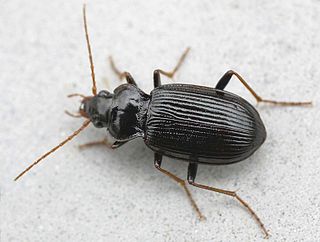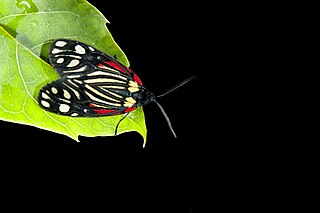Related Research Articles

The black-headed sibia is a bird species in the family Leiothrichidae. In former times it was often included with the dark-backed sibia in H. melanoleuca. Together with most other sibias, it is sometimes separated in the genus Malacias.

The dark-backed sibia is a bird species in the family Leiothrichidae. In former times it was included the black-headed sibia, H. desgodinsi. Together with most other sibias, it is sometimes separated in the genus Malacias. It is found in China, Myanmar and Thailand. Its natural habitat is subtropical or tropical moist montane forests.

Nebria is a genus of ground beetles native to the Palearctic, the Near East and North Africa. There are more than 500 described species in Nebria.

Nebria brevicollis is a species of ground beetle native to Europe and the Near East. In Europe, it is found in all countries and islands except the Azores, the Canary Islands, the Channel Islands, Franz Josef Land, Gibraltar, Madeira, Malta, Monaco, the North Aegean Islands, Novaya Zemlya, San Marino, the Selvagens Islands, Svalbard and Jan Mayen, and Vatican City. It has now been reported as introduced in western Oregon, U.S.A., where it has been found in highly disturbed sites as well as in native old-growth forest stands. It has also now been found in Washington State, Northern California, as well as in Southern British Columbia, Canada(See external link to iNaturalist, below). This species is most abundant between October and December, then from January through mid-May. Although Nebria brevicollis is widely considered to be solely carnivorous, multiple small studies made by enthusiasts have proven that many Nebria brevicollis will resort to eating various types of fungi that can be found in the soil they live on/around. Studied made by the same individuals have also shown that Nebria brevicollis are semi-social, and will often work together when faced with certain obstacles.

Nebria livida is a species of ground beetle with two subspecies:

Nebriinae is a subfamily of ground beetles in the family Carabidae. There are about 12 genera and more than 840 described species in Nebriinae.
Nebria aetolica is a species of ground beetle in the Nebriinae subfamily that can be found in Albania, Greece, and North Macedonia.
Nebria dahlii is a species in the beetle family Carabidae, found in Europe.
Nebria kratteri is a species in the beetle family Carabidae. It is found in Italy, North Macedonia, Albania, and Greece.
Nebria orsinii is a species of ground beetle in the Nebriinae subfamily that is endemic to Italy.
Nebria peristerica is a species of ground beetle in the Nebriinae family that can be found in Greece and North Macedonia.
Nebria punctatostriata is a species of ground beetle in the Nebriinae subfamily that can be found in Portugal and Spain.
Nebria rubripes is a species of ground beetle in the Nebriinae subfamily that can be found in France and Spain.
Nebria tatrica is a species of ground beetle in the Nebriinae subfamily that can be found in Poland Czech Republic and Slovakia.
Nebria laticollis is a species of ground beetle in the Nebriinae subfamily that can be found in France, Italy, and Switzerland.
Nebria cordicollis is a species of black coloured ground beetle from Nebriinae subfamily that can be found in Switzerland, Italy, and Germany. The species is about 5 millimetres (0.20 in) long.
Lesticus desgodinsi is a species of ground beetle in the subfamily Pterostichinae. It was described by Tschitscherine in 1894.
Tyrrhenia may refer to:

Campylotes is a genus of day-flying moths of the family Zygaenidae. The genus was erected by John O. Westwood in 1840.
References
- ↑ "Nebria desgodinsi Oberthür, 1883". Catalogue of Life. Retrieved 2023-04-08.